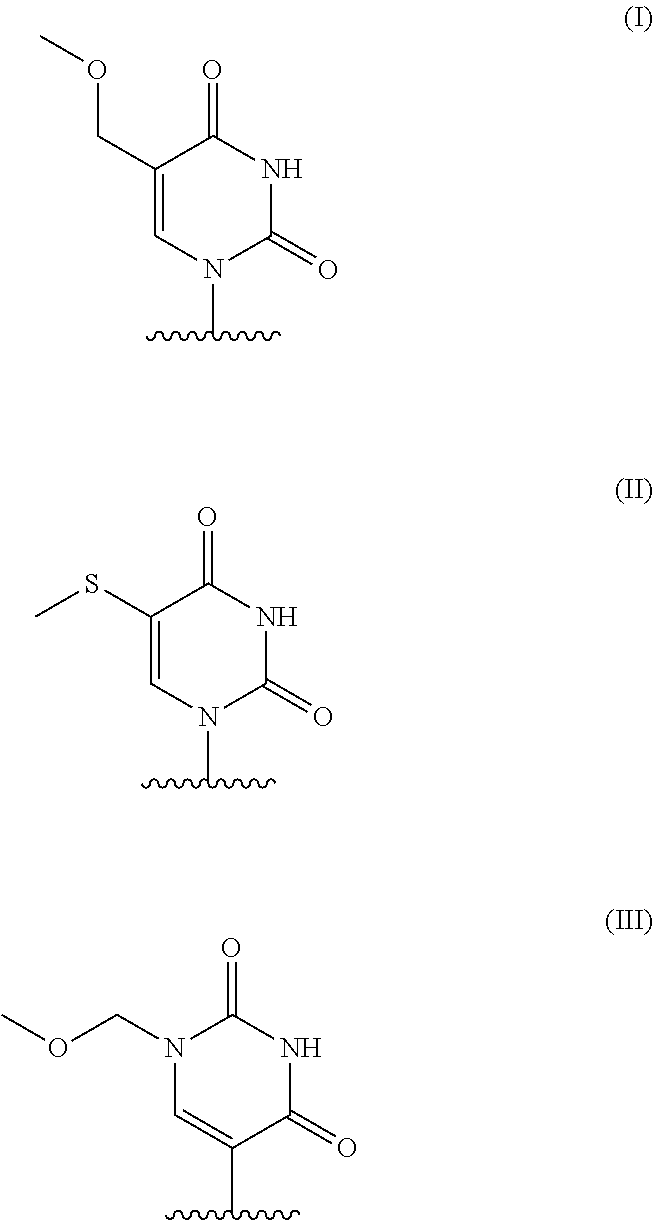Chemically modified messenger RNA's
a messenger rna, chemically modified technology, applied in the direction of dna/rna fragmentation, organic chemistry, sugar derivatives, etc., can solve the problems of difficult to obtain dna expression in cells, alterations and/or damage to the genomic dna of the host cell,
- Summary
- Abstract
- Description
- Claims
- Application Information
AI Technical Summary
Benefits of technology
Problems solved by technology
Method used
Image
Examples
example 1
on of 5-methoxymethyluridine triphosphate
[0229]
[0230]5-Methoxymethyluridine (35 mg, 0.12 mmol) (Carbohydrate Research 2011, 2136) was taken up in trimethyl phosphate (1.2 mL) and cooled to 0° C. Proton sponge (52 mg, 0.24 mmol) was added, and the mixture was stirred at 0° C. for 15 min. To this was added POCl3 (28 μL, 0.309 mmol) dropwise. The mixture was stirred at 0° C. for 2.5 h. The mixture was cooled to −15° C., and DMF (0.8 mL) solution of tributylammonium pyrophosphate (466 mg, 0.850 mmol) and tributylamine (87 μL, 0.36 mmol) was added. The mixture was stirred at this temperature for 1 h 50 min and then added to 0.2 M (pH 8.5) aqueous triethylammonium bicarbonate (TEAB) (7 mL). The mixture was stirred at RT for 50 min and then freeze-dried by lyophilizer to give the crude product as semi-dry solid. This was taken up in acetonitrile (5 mL), MeOH (1 mL) and triethylamine (400μL, 2.88 mmol) was added. The mixture was gently shaked for 5 min and concentrated. The residue was take...
example 2
on of 5-methylthiouridine triphosphate
[0232]
[0233]MAE679 was prepared in the same manner as MAY021 from 5-methylthiouridine (Journal of heterocyclic chemistry 1979, 16, 1049).
[0234]1H NMR (400 MHz, D2O) δ 7.85 (s, 1H), 5.92 (d, J=4 Hz, 1H), 4.42-4.35 (m, 2H), 4.25-4.09 (m, 3H), 3.13 (q, J=8 Hz, 24H), 2.27 (s, 3H), 1.21 (t, J=8 Hz, 36H); 31P NMR (162 MHz, D2O—proton decoupled)δ−8.7 (br s), −11.6 (d), −22.9 (t); Mass m / z 529 (M−1).
example 3
on of 1-methoxymethylpseudouridine triphosphate
[0235]
[0236]Methoxylmethyl chloride (30 μL, 0.40 mmol) was added to a solution of triacetoxy pseudouridine (130 mg, 0.351 mmol) (Chemistry Letters 2009, 38, 174) and diisopropylethylamine (72 μL, 0.41 mmol) in MeCN (4 mL) at −30° C. The mixture was warmed to 5° C. over 3 h, concentrated and purified by HPLC to give the product as an oil (110 mg). Mass m / z 415 (M+1). This was taken up in 2 M ammonia in methanol (5 mL, 10 mmol), and the mixture was stirred at RT for 46 h. The mixture was concentrated to give the crude product which was purified by SFC to give the product as a white solid (53 mg). 1H NMR (400 MHz, CD3OD) δ 7.81 (s, 1H), 5.12 (d, J=12 Hz, 1H), 5.09 (d, J=12 Hz, 1H), 4.62 (d, J=4 Hz, 1H), 4.17 (t, J=8 Hz, 1H), 4.07 (t, J=8 Hz, 1H), 3.95-3.91 (m, 1H), 3.81 (dd, J=12, 4 Hz, 1H), 3.66 (dd, J=12, 4 Hz, 1H), 3.37 (s, 3H); Mass m / z 289 (M+1).
[0237]
[0238]Example 3 was prepared in the same manner as Example from 1-methoxymethylpseud...
PUM
| Property | Measurement | Unit |
|---|---|---|
| pH | aaaaa | aaaaa |
| temperature | aaaaa | aaaaa |
| pH | aaaaa | aaaaa |
Abstract
Description
Claims
Application Information
 Login to View More
Login to View More - R&D
- Intellectual Property
- Life Sciences
- Materials
- Tech Scout
- Unparalleled Data Quality
- Higher Quality Content
- 60% Fewer Hallucinations
Browse by: Latest US Patents, China's latest patents, Technical Efficacy Thesaurus, Application Domain, Technology Topic, Popular Technical Reports.
© 2025 PatSnap. All rights reserved.Legal|Privacy policy|Modern Slavery Act Transparency Statement|Sitemap|About US| Contact US: help@patsnap.com



